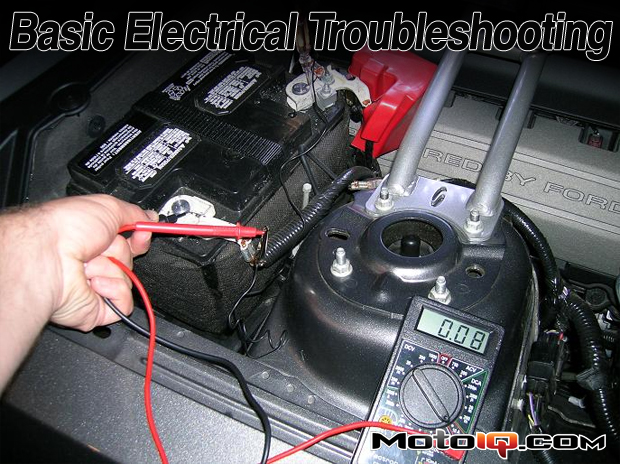,
Because current flows through an object, the only way to measure it is to measure it through the DMM, as well. In order to do this, we must physically break the circuit and add the DMM into it.
 |
|
In this diagram, we’ve disconnected the resistor from the battery and reconnected it through the DMM. |
Never, NEVER connect a DMM set to measure current across an object. A DMM set to measure current has an extremely low internal resistance. Connecting it across an object shorts the object (and thus the power source) to ground, which will blow the internal fuse in the DMM and make it worthless. It could also damage your car’s electrical system.
 |
|
Here, I am measuring the current through the test light. Note how this is hooked up. The test light is connected to the positive battery terminal. The ground from the test light is hooked up to one probe in the DMM, and the other probe is hooked to the negative battery terminal. |
The final thing you can measure with a DMM is resistance. A DMM being used to measure resistance is called an ohmmeter. In order to do this, the resistor must be removed from the circuit and the DMM’s probes connected to either side of it.

There are lots of different settings for resistance measurement on the DMM. Each setting is for a different magnitude of resistance. Start with the highest setting and keep lowering it until you get a reading. Measuring resistance in automotive systems isn’t terribly useful unless you’re measuring windings on a “dumb” ignition coil. However, you can also use it to measure resistance between a point on the vehicle electrical system and chassis ground, which is useful in tracking down a bad ground connection.
Now let’s look at a couple examples of how to use these tools so you can get a better idea of how to use them in real-life situations.
Troubleshooting a Persistent Dead Battery
I think everybody’s had this problem at least once in their lives: a car whose battery dies all the time and needs a jump start. Of course, it could be that the battery is just old. If you suspect that is the problem, take the battery to an autoparts store and have them test it. But if the battery itself is not the problem, then your car’s electrical system is. Something is draining the battery.
The easiest way to figure out what is draining your battery is to use the DMM to measure the current being drawn from it while the car is off. Disconnect the negative battery terminal and connect the DMM (set up to measure current) between the negative battery terminal and the cable that it normally connects to. Now take a look at the current measurement on the screen. (Note that you’ll have to wait several seconds if the battery has been disconnected for any length of time; a car’s computer will pull a bit of extra current when it’s first connected, since it needs to power up its capacitors and such.)
Most ECUs in cars pull 50 milliamps (mA) or less when the engine is off. If there is 100 mA or more being registered on the DMM, there is a parasitic drain in your electrical system somewhere. With the DMM still connected, pull fuses one at a time until that current drops to where it should be. That will let you isolate the circuit that is causing the problem.



